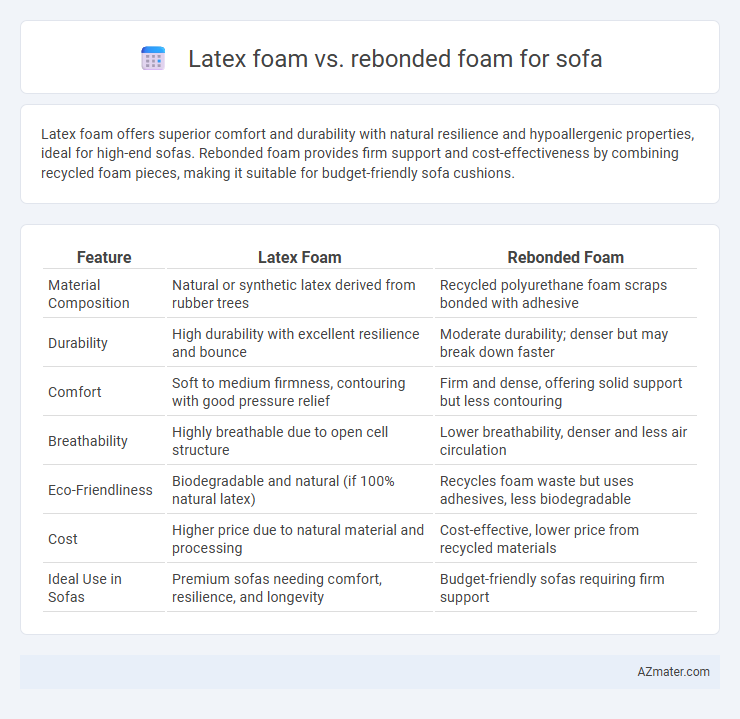Latex foam offers superior comfort and durability with natural resilience and hypoallergenic properties, ideal for high-end sofas. Rebonded foam provides firm support and cost-effectiveness by combining recycled foam pieces, making it suitable for budget-friendly sofa cushions.
Table of Comparison
| Feature | Latex Foam | Rebonded Foam |
|---|---|---|
| Material Composition | Natural or synthetic latex derived from rubber trees | Recycled polyurethane foam scraps bonded with adhesive |
| Durability | High durability with excellent resilience and bounce | Moderate durability; denser but may break down faster |
| Comfort | Soft to medium firmness, contouring with good pressure relief | Firm and dense, offering solid support but less contouring |
| Breathability | Highly breathable due to open cell structure | Lower breathability, denser and less air circulation |
| Eco-Friendliness | Biodegradable and natural (if 100% natural latex) | Recycles foam waste but uses adhesives, less biodegradable |
| Cost | Higher price due to natural material and processing | Cost-effective, lower price from recycled materials |
| Ideal Use in Sofas | Premium sofas needing comfort, resilience, and longevity | Budget-friendly sofas requiring firm support |
Introduction: Latex Foam vs Rebonded Foam for Sofas
Latex foam offers superior comfort and resilience for sofas due to its natural elasticity and breathability, making it ideal for long-term use. Rebonded foam consists of shredded foam scraps bonded together, providing high density and firm support but less durability and cushioning compared to latex. Choosing between latex foam and rebonded foam depends on the balance between comfort, support, and budget preferences for sofa cushions.
What is Latex Foam?
Latex foam is a natural or synthetic material known for its exceptional elasticity, durability, and comfort, commonly used in sofa cushions to provide consistent support and pressure relief. Its open-cell structure enhances breathability and moisture resistance, contributing to a cooler and more hygienic seating experience compared to rebonded foam, which is made from shredded foam scraps bonded together. Latex foam's resilience and hypoallergenic properties make it a premium choice for sofas aimed at combining comfort with long-lasting performance.
What is Rebonded Foam?
Rebonded foam is manufactured by shredding scrap foam pieces and bonding them together using adhesives under high pressure and heat, creating a dense and durable material ideal for sofa cushions requiring firm support. Compared to latex foam, rebonded foam offers higher resilience and cost-effectiveness but generally lacks the natural elasticity and breathability of latex. Its robust composition makes it suitable for heavy-use furniture, providing long-lasting comfort and shape retention.
Comfort and Support Comparison
Latex foam offers superior comfort with its natural elasticity and responsiveness, conforming closely to body contours for pressure relief and consistent support. Rebonded foam, made from shredded foam pieces bonded together, provides firmer support but may lack the same level of cushioning and breathability as latex. For sofa cushions, latex foam excels in durability and comfort, while rebonded foam is better suited for budget-friendly, high-density support options.
Durability and Longevity
Latex foam offers superior durability and longevity due to its natural elasticity and resistance to wear, maintaining shape and comfort over years of use. Rebonded foam, made from recycled foam scraps compressed together, provides moderate durability but tends to lose resilience and firmness quicker than latex foam under frequent pressure. Choosing latex foam enhances sofa lifespan with better support and bounce-back properties, making it ideal for long-term seating solutions.
Breathability and Temperature Control
Latex foam offers superior breathability due to its open-cell structure and natural ventilation channels, promoting excellent airflow and effective temperature regulation. Rebonded foam, composed of compressed foam scraps, has a denser, less porous composition that limits air circulation and retains heat more easily. Selecting latex foam for sofa cushions enhances comfort by maintaining a cooler, well-ventilated seating surface compared to the heat-trapping nature of rebonded foam.
Allergy and Health Considerations
Latex foam is naturally hypoallergenic and resistant to dust mites, mold, and bacteria, making it a preferred choice for individuals with allergies or respiratory issues. Rebonded foam, composed of recycled foam bonded together with adhesives, may retain chemical residues and off-gas volatile organic compounds (VOCs), potentially triggering allergic reactions and impacting indoor air quality. Choosing natural latex foam supports better health outcomes by minimizing exposure to allergens and harmful substances often found in rebonded foam.
Cost Differences: Latex vs Rebonded Foam
Latex foam typically costs significantly more than rebonded foam due to its natural materials and superior durability. Rebonded foam, made from recycled foam scraps, offers a budget-friendly alternative but usually lacks the longevity and comfort of latex foam. Choosing between latex and rebonded foam for sofas depends on balancing upfront investment with long-term performance and comfort requirements.
Environmental Impact and Sustainability
Latex foam, derived from natural rubber, offers superior biodegradability and renewable sourcing compared to rebonded foam, which is made by recycling polyurethane foam scraps and often contains synthetic chemicals. Both materials contribute to waste reduction, but latex foam's natural origin and lower emissions during production make it a more sustainable option for eco-conscious furniture. Choosing latex foam for sofas supports a circular economy by reducing reliance on petroleum-based products and enhancing indoor air quality through its hypoallergenic properties.
Which Sofa Foam is Best for You?
Latex foam offers superior comfort with its natural elasticity and breathability, making it ideal for those seeking long-lasting support and hypoallergenic properties in a sofa. Rebonded foam, made from shredded foam scraps bonded together, provides high durability and firmness at a lower cost, suitable for budget-conscious buyers who prioritize resilience over softness. Choosing the best sofa foam depends on personal preferences for comfort, durability, and budget, with latex foam favored for premium seating and rebonded foam commonly used in value-focused furniture.

Infographic: Latex foam vs Rebonded foam for Sofa
 azmater.com
azmater.com